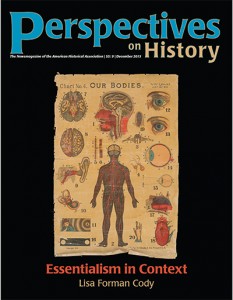One of the pleasures of editing Perspectives on History is the opportunity to work with authors committed to history in so many of its facets—including but not limited to academic research, public history, and teaching—covering as many fields as we can. We aim to serve the AHA membership, the discipline, and increasingly the lay public: these entities all have a stake in what historians think and do.
 That’s why I’d first like to draw your attention to executive director James Grossman’s column for this month, “Everything Has a History.” Since much of our membership has pursued or is pursuing advanced historical studies, this might seem obvious. But Grossman argues that a lack of historical awareness suffuses the world we inhabit—a situation that historians can help change. “I propose that most historians ought to be capable of functioning in public arenas, ought to be capable of at least reminding our neighbors that everything has a history,” he writes.
That’s why I’d first like to draw your attention to executive director James Grossman’s column for this month, “Everything Has a History.” Since much of our membership has pursued or is pursuing advanced historical studies, this might seem obvious. But Grossman argues that a lack of historical awareness suffuses the world we inhabit—a situation that historians can help change. “I propose that most historians ought to be capable of functioning in public arenas, ought to be capable of at least reminding our neighbors that everything has a history,” he writes.
This relates to our cover story, Lisa Forman Cody’s “Essentialism in Context.” As last summer’s headlines about Caitlyn Jenner and Rachel Dolezal demonstrated, questions about whether identity is a social construction or something one is born with fascinate many people, including history learners and teachers. Cody argues that deploring scientific and medical discourse about race and gender as purely essentialist tends to obscure the fact that essentialism itself has a history. Her narrative of how scientific essentialism developed in the Enlightenment and its implications for current teaching is a must-read.
We’re privileged to welcome the renowned sculptor Rob Firmin to our pages for insights on how an artist performs historical research. As Firmin explains, research not only ensures accurate representation, but also provides inspiration for the piece itself. With collaborator Eugene Daub, Firmin has created memorial sculptures of Abraham Lincoln, Thomas Jefferson, the Tuskegee Airmen, Harvey Milk, and perhaps most notably the bronze Rosa Parks, which sits in the US Capitol Statuary Hall. As an artist who works with archival materials and has a distinct historical methodology, Firmin offers a unique perspective on engaging the public in historical reflection.
Those of us who are teachers are familiar with the fair amount of anxiety that goes into figuring out how to engage students and what precisely they take from our courses. The AHA Tuning project has enumerated specific skills the study of history can impart and ways to teach and measure them. But Mary Jo Festle and her department at Elon University have taken an additional step: asking students themselves how history courses change them. As Festle writes, students answer prompts about such topics as how their understanding of “what history is” has changed and whether studying history challenged their worldviews in positive ways. We think you’ll find the results intriguing.
Our last feature sees the return of Robert Townsend to the pages of Perspectives, with “The Rise and Decline of History Specializations over the Past 40 Years.” Using data compiled from the AHA Directory of History Departments, Historical Organizations, and Historians, Townsend seeks to determine trends in the relative representation of different fields in departments of history since 1975. If you’ve ever wondered whether your field has expanded or contracted over the past four decades, you’ll want to read it.
Lastly, I’d like to direct you to a contribution by staff member Sadie Bergen in our News section: “History from Below: Turning Divers into Underwater Archaeological Advocates.” Bergen writes of the efforts of Diving with a Purpose (DWP), an organization that “aims to preserve and protect the human history that lies underwater as an alternative to treasure hunting.” Focusing on preserving the maritime heritage of sites with relevance to African American history, DWP is one of the major partners in the Slave Wrecks Project, which in 2014 documented the wreck of an 18th-century slave ship off the coast of South Africa. As Bergen reveals, members of the public share historians’ desire to engage with and analyze the past, no matter the challenges presented.
There’s much more in the December issue. You can browse the entire issue here.
This post first appeared on AHA Today.
Tags: AHA Activities AHA Today
Comment
Please read our commenting and letters policy before submitting.






